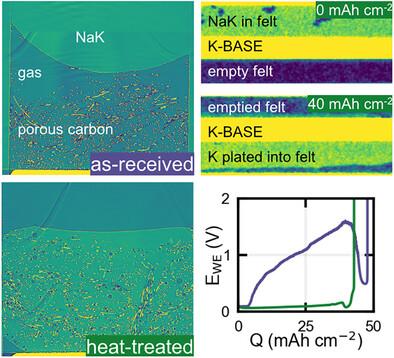Wetting Interactions Between Porous Carbon Hosts and Liquid Sodium-Potassium Alloys Toward Their Use in Negative Electrodes of Alkali-Metal Batteries
IF 19
1区 材料科学
Q1 CHEMISTRY, MULTIDISCIPLINARY
引用次数: 0
Abstract
Batteries with liquid alkali-metal negative electrodes offer a route to compact, high-performance energy storage. Innovation in alkali-metal management, i.e., controlled storage, release and transport of liquid alkali metal, can enable simpler and cheaper cell designs. Porous carbons have emerged as potential host materials for liquid alkali metals. Here, X-ray computed tomography is used to study the wetting interactions between porous carbon hosts and liquid sodium-potassium alloy (NaK) as a function of carbon host morphology and surface functionalization. While as-received carbon samples show no affinity toward NaK, heat-treated carbon is spontaneously infiltrated with NaK filling almost the entire pore volume. It is explored how forced wetting partially fills pores of NaK-repellant hosts, showing large differences in pore filling based on the average pore size of the host material. In electrochemical discharge experiments, it is shown that both as-received and heat-treated carbon felt enable high areal capacities beyond 40 mAh cm−2. However, the heat-treated carbon shows ten times lower overpotential. Finally, it is demonstrated how heat-treated carbon felt can enable capillary transport of NaK. In summary, this study elucidates important aspects of the interactions between liquid alkali metals and porous carbon hosts, generating insights into possible applications in liquid alkali-metal batteries.

多孔碳基质与液态钠钾合金在碱金属电池负极中的润湿相互作用
带有液态碱金属负极的电池提供了一种紧凑、高性能的能量存储方式。碱金属管理方面的创新,即控制液态碱金属的储存、释放和运输,可以使电池设计更简单、更便宜。多孔碳已成为液态碱金属的潜在宿主材料。本文利用x射线计算机断层扫描技术研究了多孔碳载体与液态钠钾合金(NaK)之间的润湿相互作用,作为碳载体形态和表面功能化的函数。虽然接收的碳样品对NaK没有亲和力,但热处理后的碳会自发地渗透NaK, NaK几乎填满整个孔隙体积。研究探讨了强制润湿如何部分填充nak -驱虫宿主的孔隙,显示了基于宿主材料平均孔径的孔隙填充的巨大差异。在电化学放电实验中,实验结果表明,接收态和热处理态的碳毡均具有超过40 mAh cm−2的高面容量。然而,经过热处理的碳显示出低10倍的过电位。最后,证明了热处理碳毡如何能够使NaK的毛细管输送。总之,这项研究阐明了液态碱金属和多孔碳宿主之间相互作用的重要方面,为液态碱金属电池的可能应用提供了见解。
本文章由计算机程序翻译,如有差异,请以英文原文为准。
求助全文
约1分钟内获得全文
求助全文
来源期刊

Advanced Functional Materials
工程技术-材料科学:综合
CiteScore
29.50
自引率
4.20%
发文量
2086
审稿时长
2.1 months
期刊介绍:
Firmly established as a top-tier materials science journal, Advanced Functional Materials reports breakthrough research in all aspects of materials science, including nanotechnology, chemistry, physics, and biology every week.
Advanced Functional Materials is known for its rapid and fair peer review, quality content, and high impact, making it the first choice of the international materials science community.
 求助内容:
求助内容: 应助结果提醒方式:
应助结果提醒方式:


